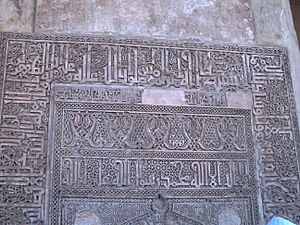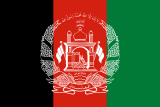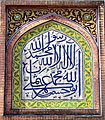Shahada facts for kids
The Shahada (Arabic: شهادة) is a very important statement of belief in Islam. It means "to testify" or "to bear witness" in Arabic. It is the Muslim declaration that there is only one God (Allah) and that Muhammad is His final prophet. Saying the Shahada is one of the Five Pillars of Islam for Muslims, and it is often said every day.
Contents
What the Shahada Says
The Shahada has two main parts. Here's what they say:
- لَا إِلَٰهَ إِلَّا ٱللَّٰهُ
- lā ʾilāha ʾillā -llāhu
- "There is no god but God."
- مُحَمَّدٌ رَسُولُ ٱللَّٰهِ
- muḥammadur rasūlu -llāh
- "Muhammad is the Messenger of God."
Often, Muslims say "I bear witness that..." before these two statements. So, the full Shahada is:
- أَشْهَدُ أَنْ لَا إِلَٰهَ إِلَّا ٱللَّٰهُ وَأَشْهَدُ أَنَّ مُحَمَّدًا رَسُولُ ٱللَّٰهِ
- ašhadu ʾan lā ʾilāha ʾilla -llāhu, wa-ʾašhadu ʾanna muḥammadan rasūlu -llāh
- "I bear witness that there is no god but God, and I bear witness that Muhammad is the Messenger of God."
Why the Shahada is Important
The first part of the Shahada, "There is no god but God," shows that Muslims believe in only one God. This God is called Allah in Arabic. The word "ilah" means "deity" or "god," while "Allah" means "the God." This part highlights that only Allah is worthy of worship.
The second part, "Muhammad is the Messenger of God," means Muslims accept Muhammad as God's prophet. It also reminds them to respect all the prophets who came before him. While the first part is a universal truth, the second part is specific to Islam.
The Shahada is a statement of both belief and worship. It is a key part of the Five Pillars of Islam. These pillars include giving to charity (zakat), performing daily prayers (Salat), fasting during Ramadan, and making a pilgrimage to the Kaaba in Mecca.
Shahada in Different Islamic Groups
In Sunni Islam, the Shahada has two parts, as mentioned above. These are sometimes called the first and second Shahada.
In Shia Islam, a third part is added to the Shahada. This part is about Ali, who was the first Shia imam. The phrase is: وَعَلِيٌّ وَلِيُّ ٱللَّٰهِ (wa ʿaliyyun waliyyu llāh). This translates to "Ali is the wali (guardian or friend) of God."
Saying the Shahada
Saying the Shahada is the most common way for Muslims to declare their faith. Both Sunnis and Shias consider it one of the Five Pillars of Islam.
It is often whispered into the ear of a newborn baby by their father. It is also whispered to a person who is dying. The five daily prayers that Muslims perform each include saying the Shahada.
Saying the Shahada is also the only formal step needed for someone to become a Muslim. When someone converts, there are often witnesses, and sometimes a celebration to welcome them. It's important that when someone says the Shahada, they truly understand what it means and say it with sincerity from their heart.
History of the Shahada
While the two parts of the Shahada are found in the Quran, they don't appear together as one statement. However, they are found combined in the Hadiths (sayings and actions of Prophet Muhammad).
Versions of the Shahada began appearing on coins and buildings in the late 600s CE. This suggests it became an official statement of faith around that time. For example, an inscription in the Dome of the Rock in Jerusalem (built around 692 CE) includes parts of the Shahada. Even though it's not clear exactly when the Shahada became common, the ideas it expresses were part of Islam from its very beginning.
Shahada in Art and Flags
The Shahada is often seen as a beautiful design element in Islamic buildings around the world. You can find it in places like Jerusalem, Cairo, and Istanbul.
The Shahada is also featured on some Islamic flags. For example, the Flag of Saudi Arabia has the Shahada written in white on a green background, with a sword below it. The Flag of Somaliland also includes the Shahada. The flag of Afghanistan under the Taliban is a white flag with the Shahada written in black.
National flags with the Shahada
-
Islamic Emirate of Afghanistan (unrecognized)
-
Republic of Somaliland (unrecognized)
Images for kids
-
A gold dinar coin from King Offa of Mercia, copied from an Abbasid coin. It includes the Arabic text "Muhammad is the Messenger of God."
-
The first part of the Shahada written in kufic calligraphy from 1309, found in Kashan, Iran.
-
The Shia Shahada on the mausoleum of Attar of Nishapur in Iran. The first part is in white, and the rest is in blue.
-
A beautiful tile panel in the Wazir Khan Mosque in Lahore, Pakistan. The Shahada is on the top half of the panel.
-
Shahadas written in the style of a Mamluk tughra (a calligraphic seal or signature).
See also
 In Spanish: Shahada para niños
In Spanish: Shahada para niños














